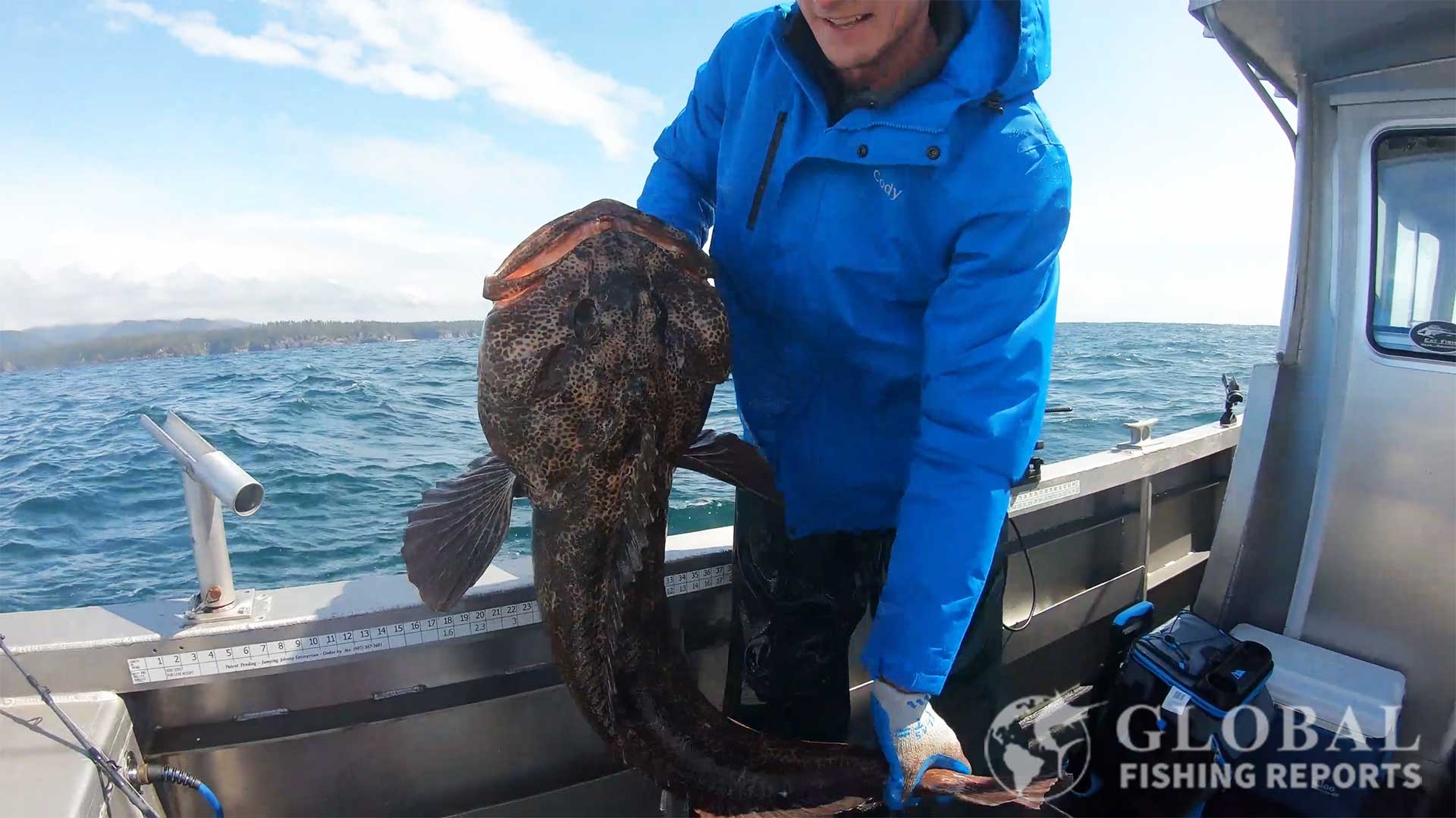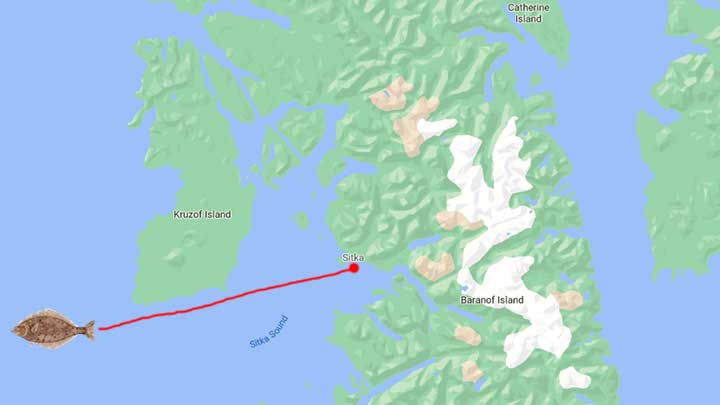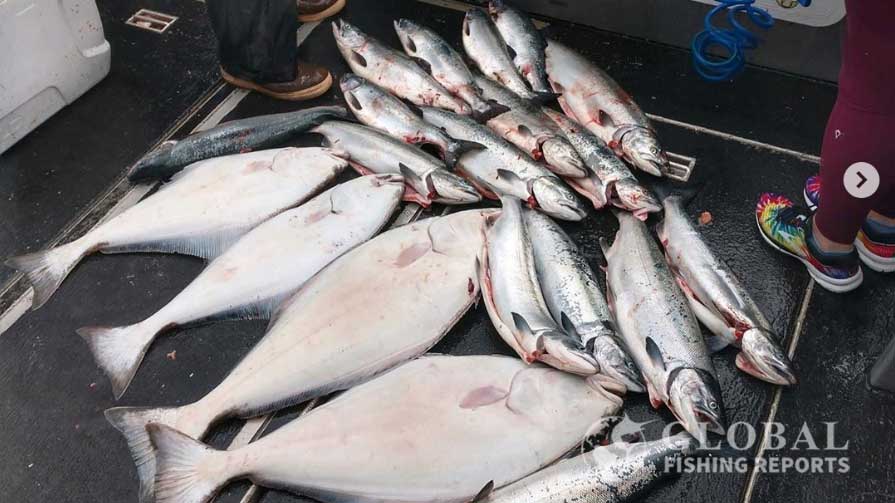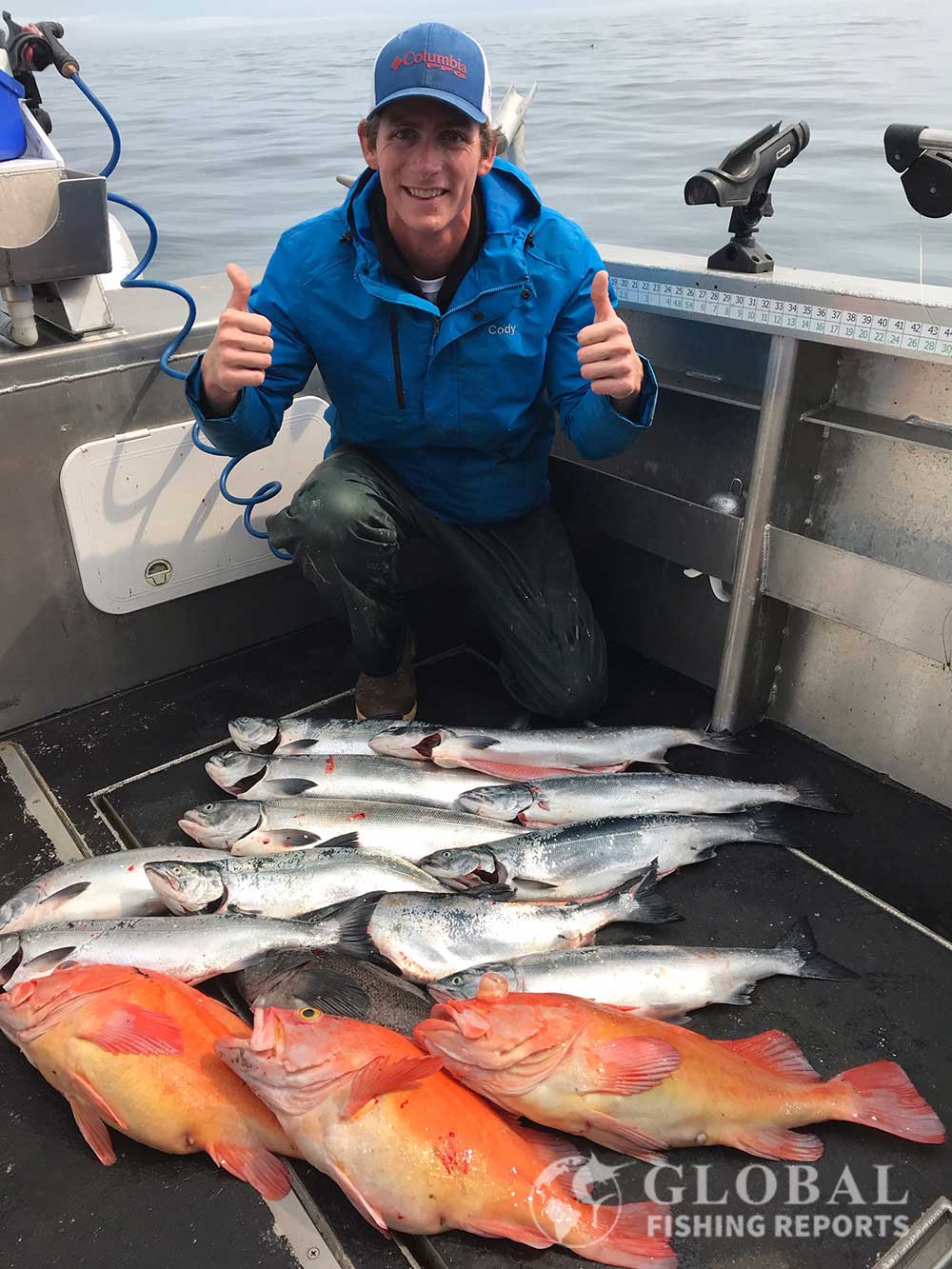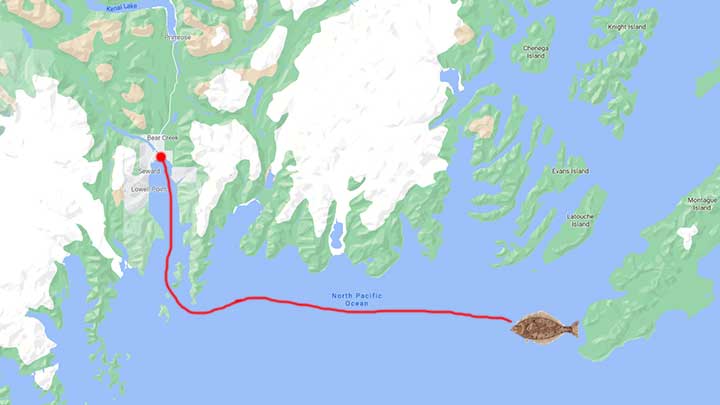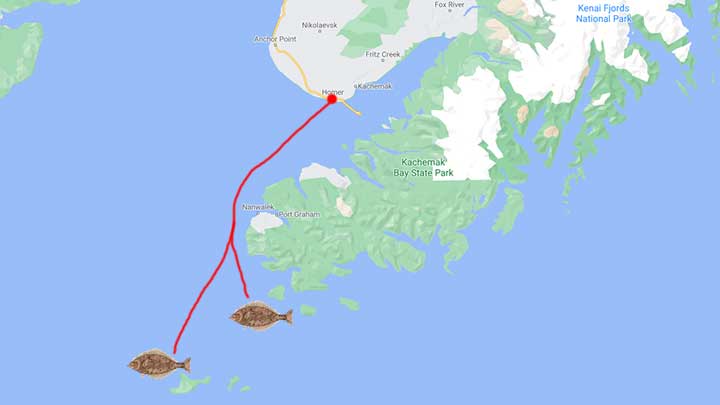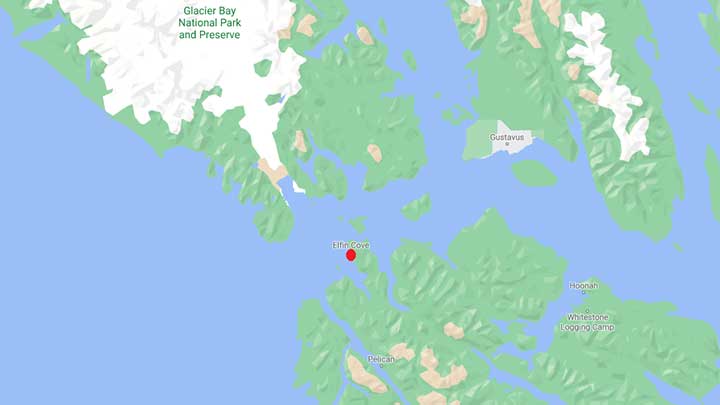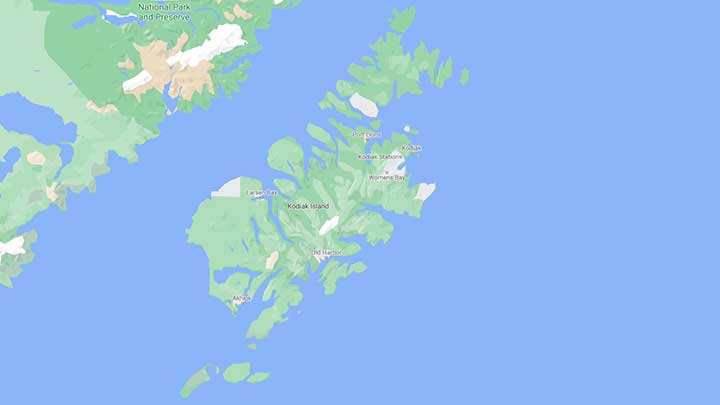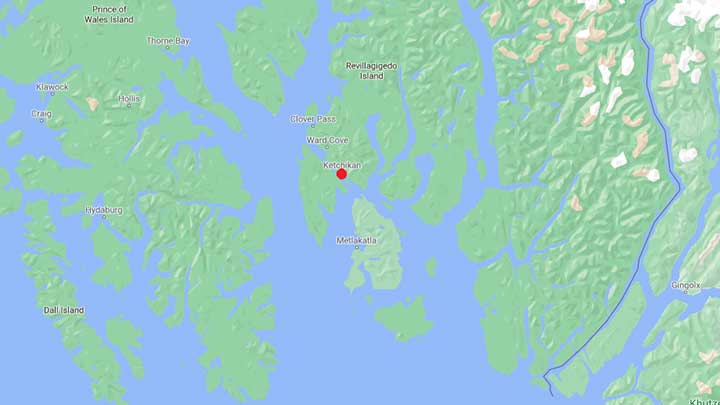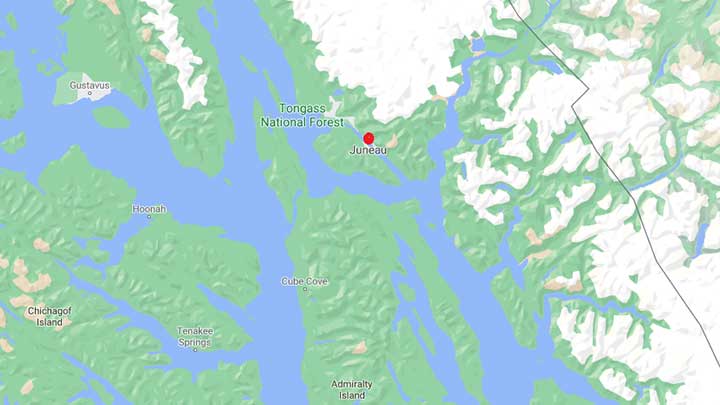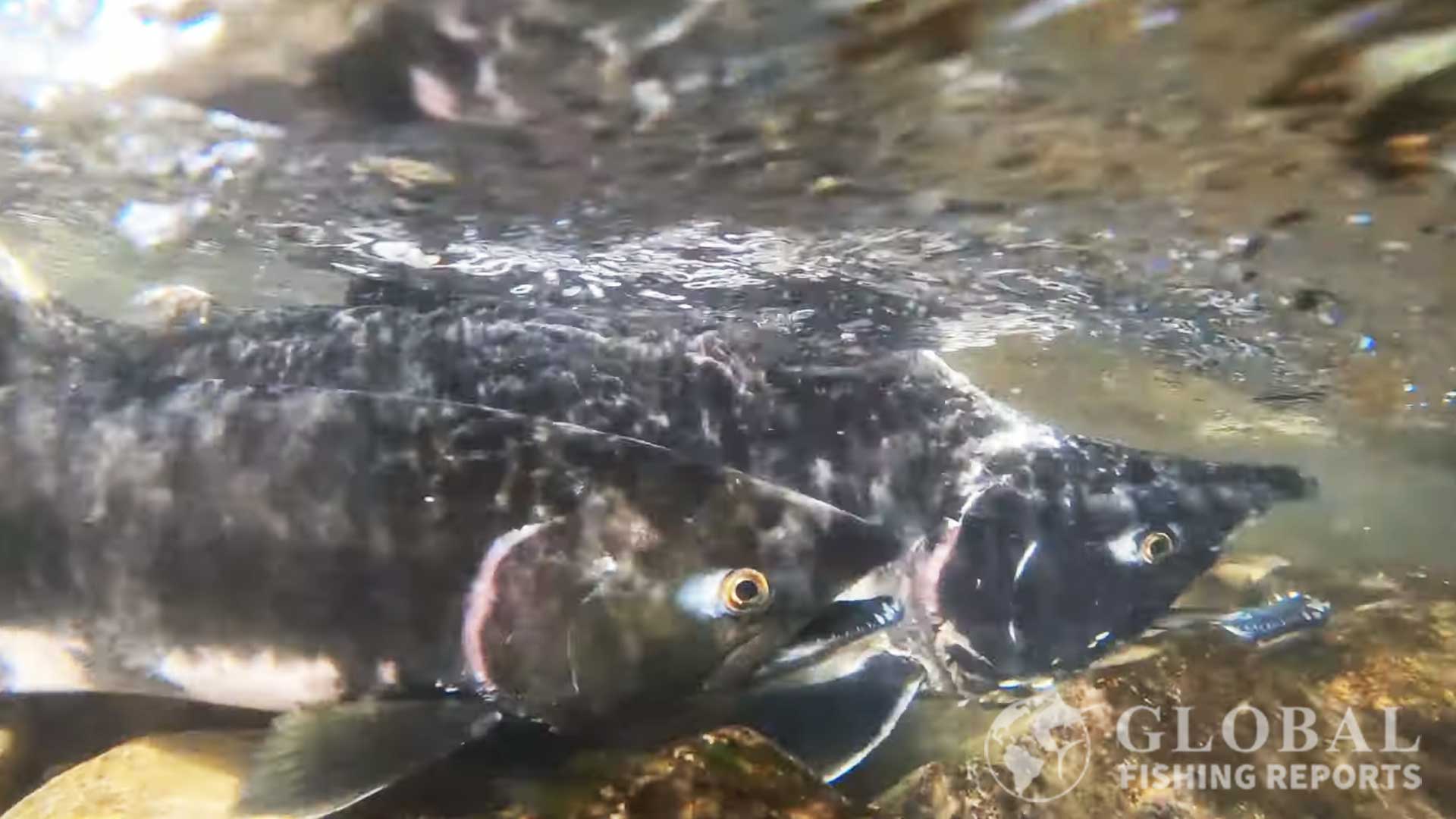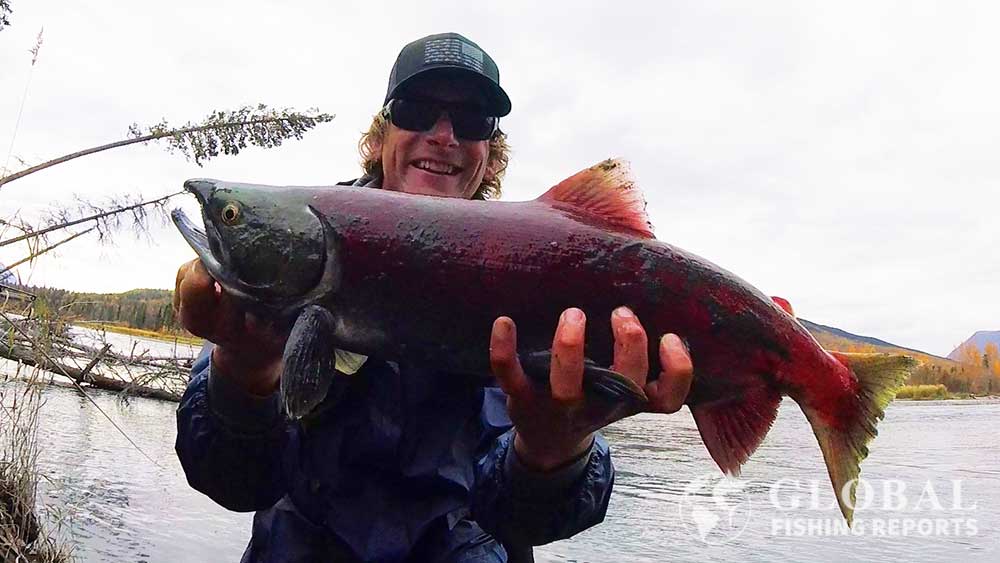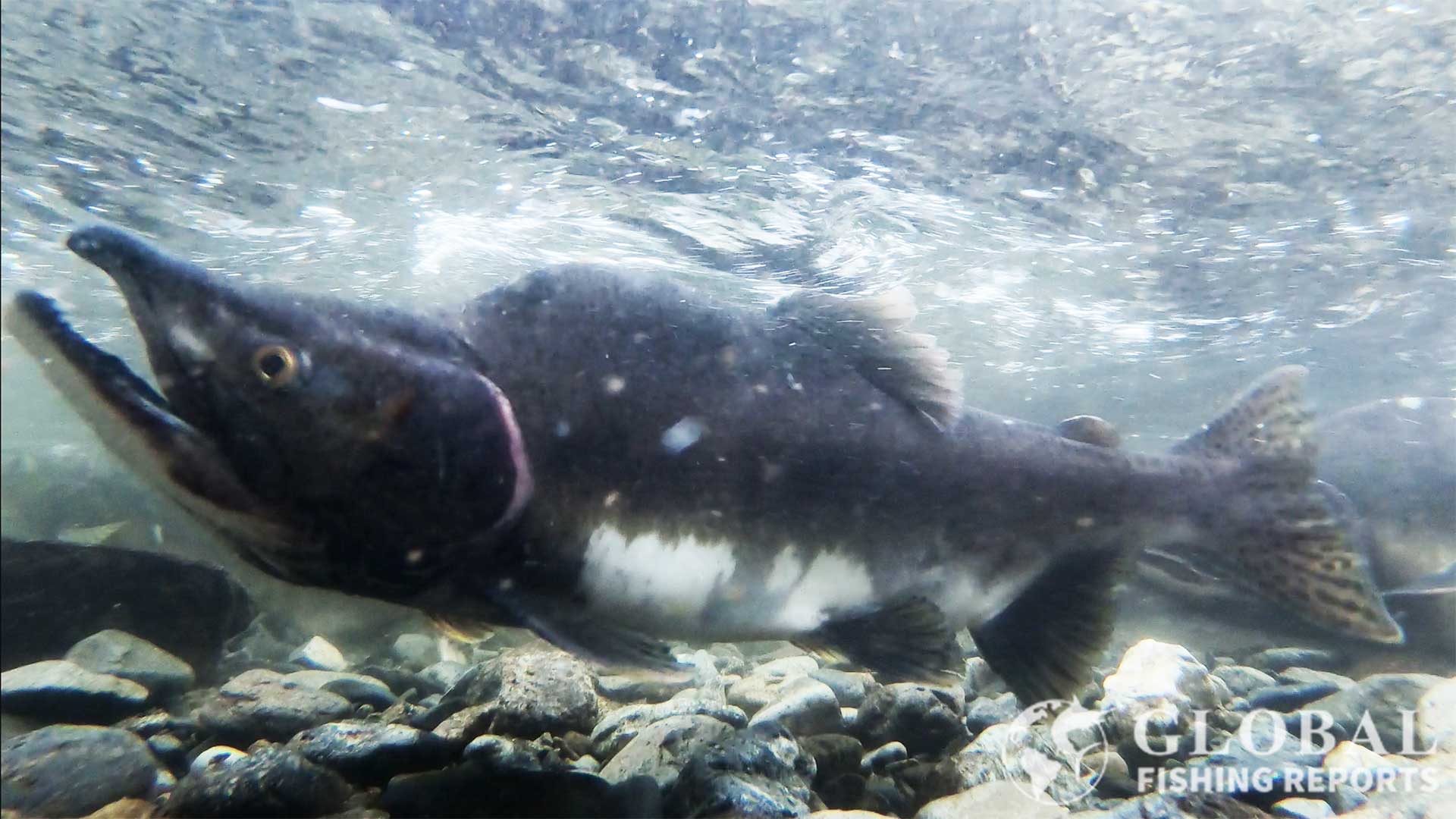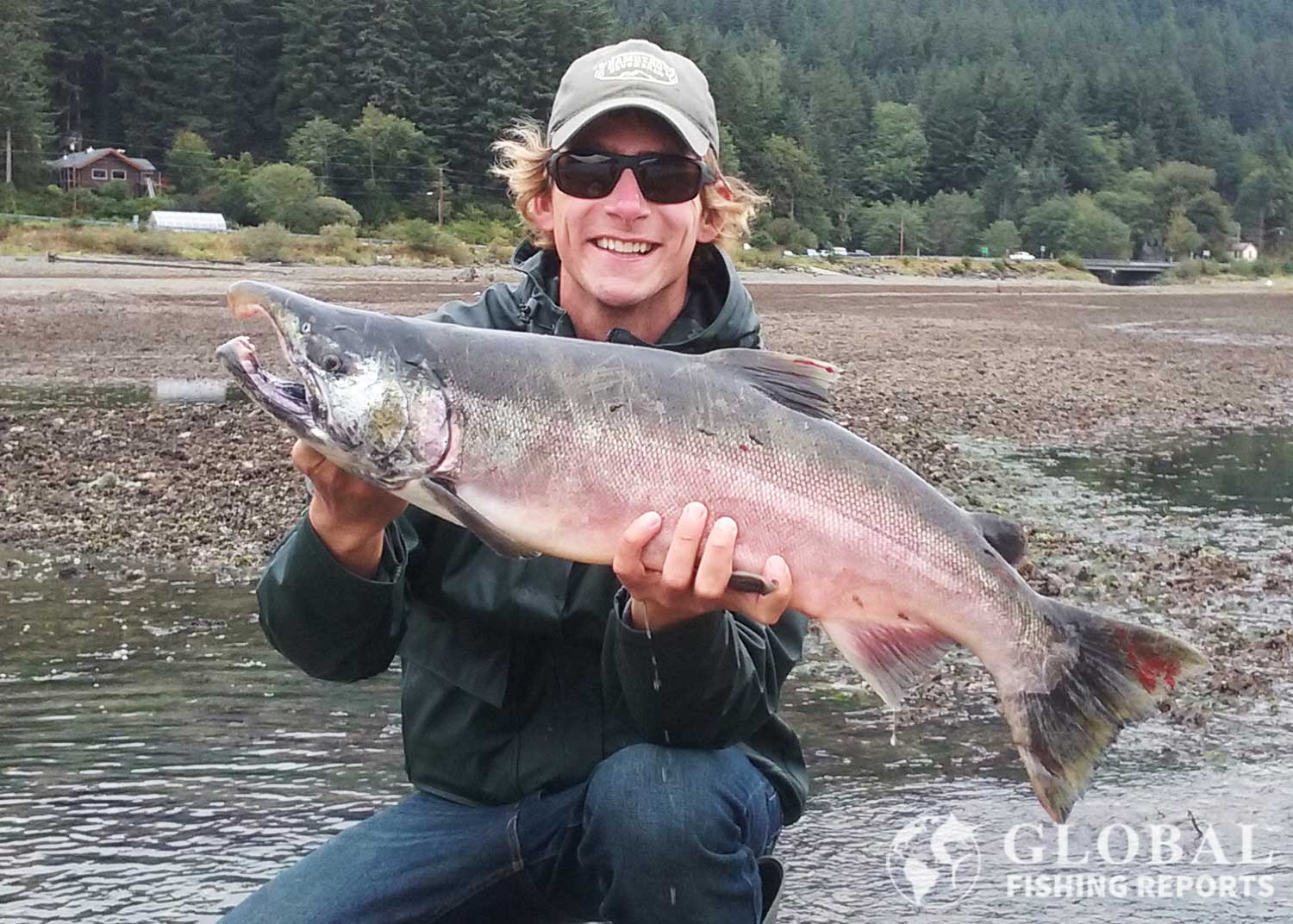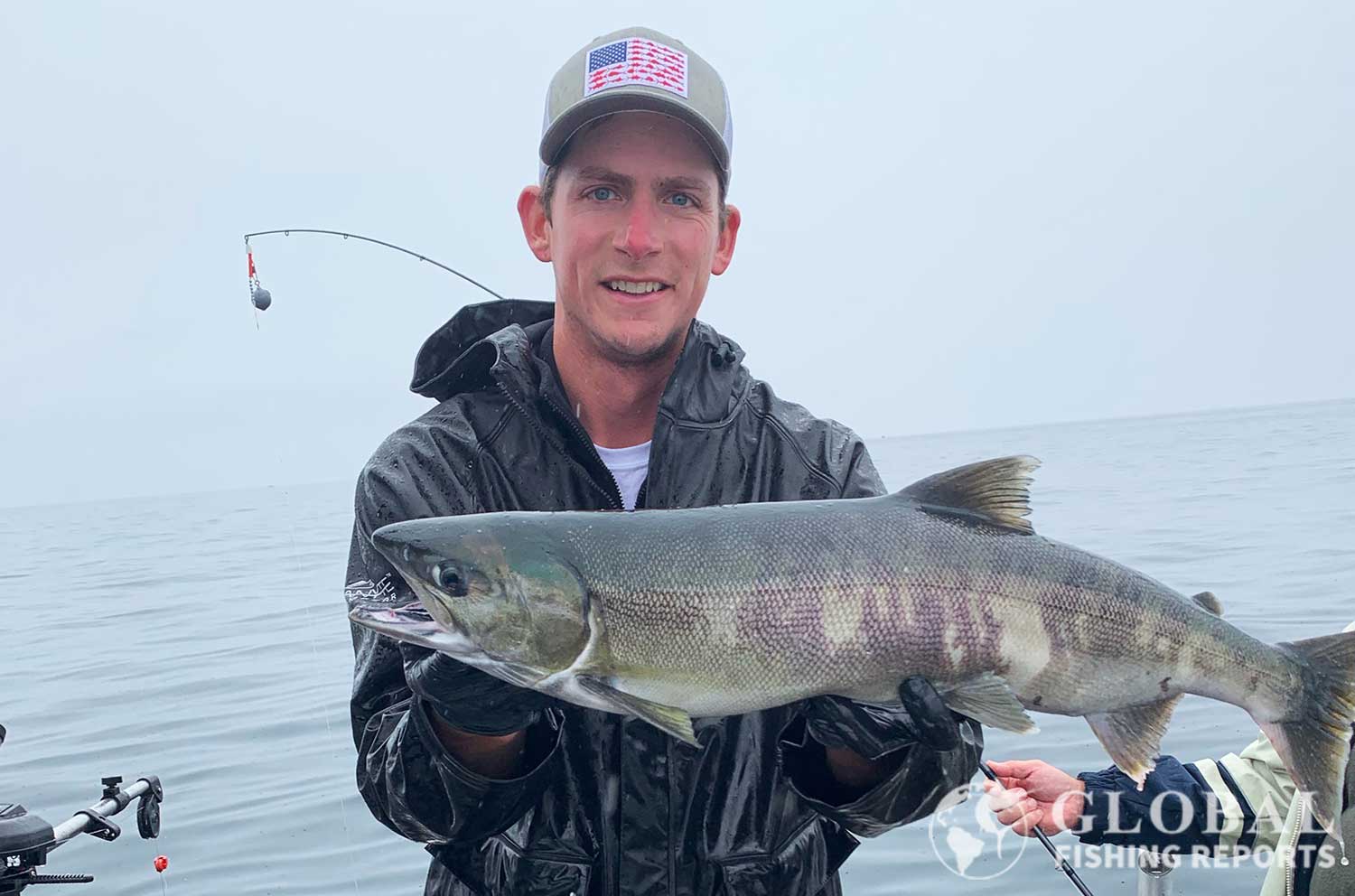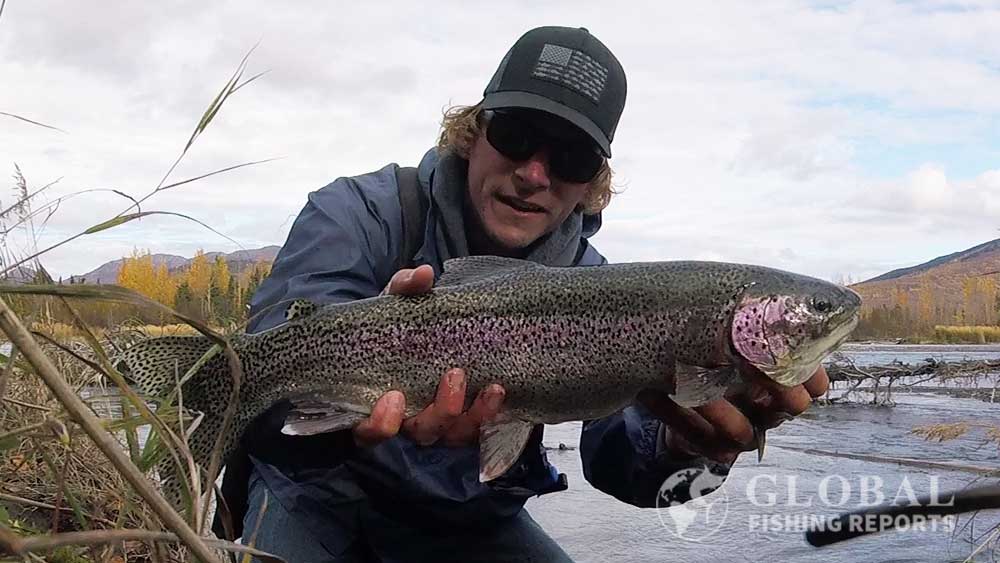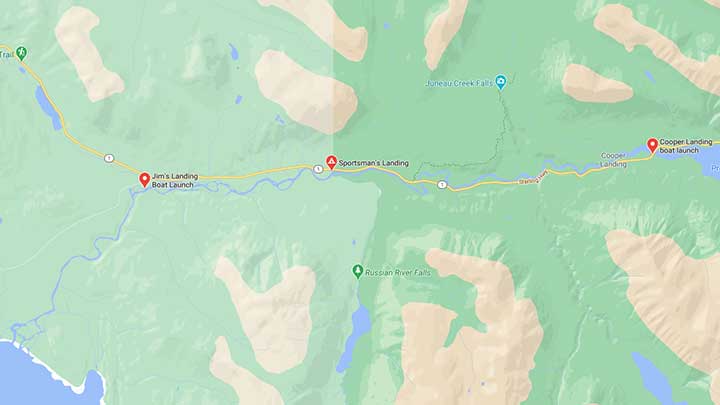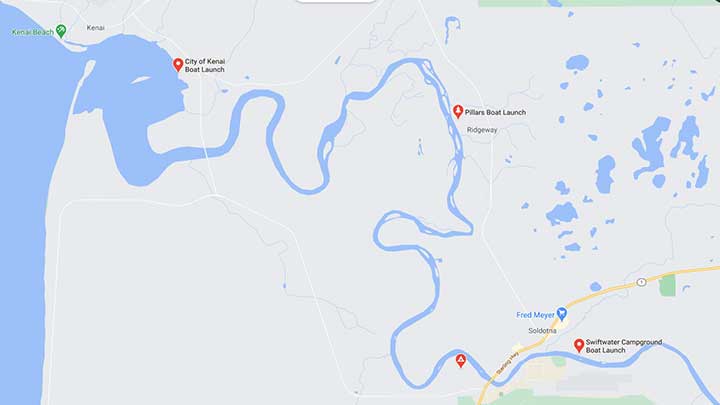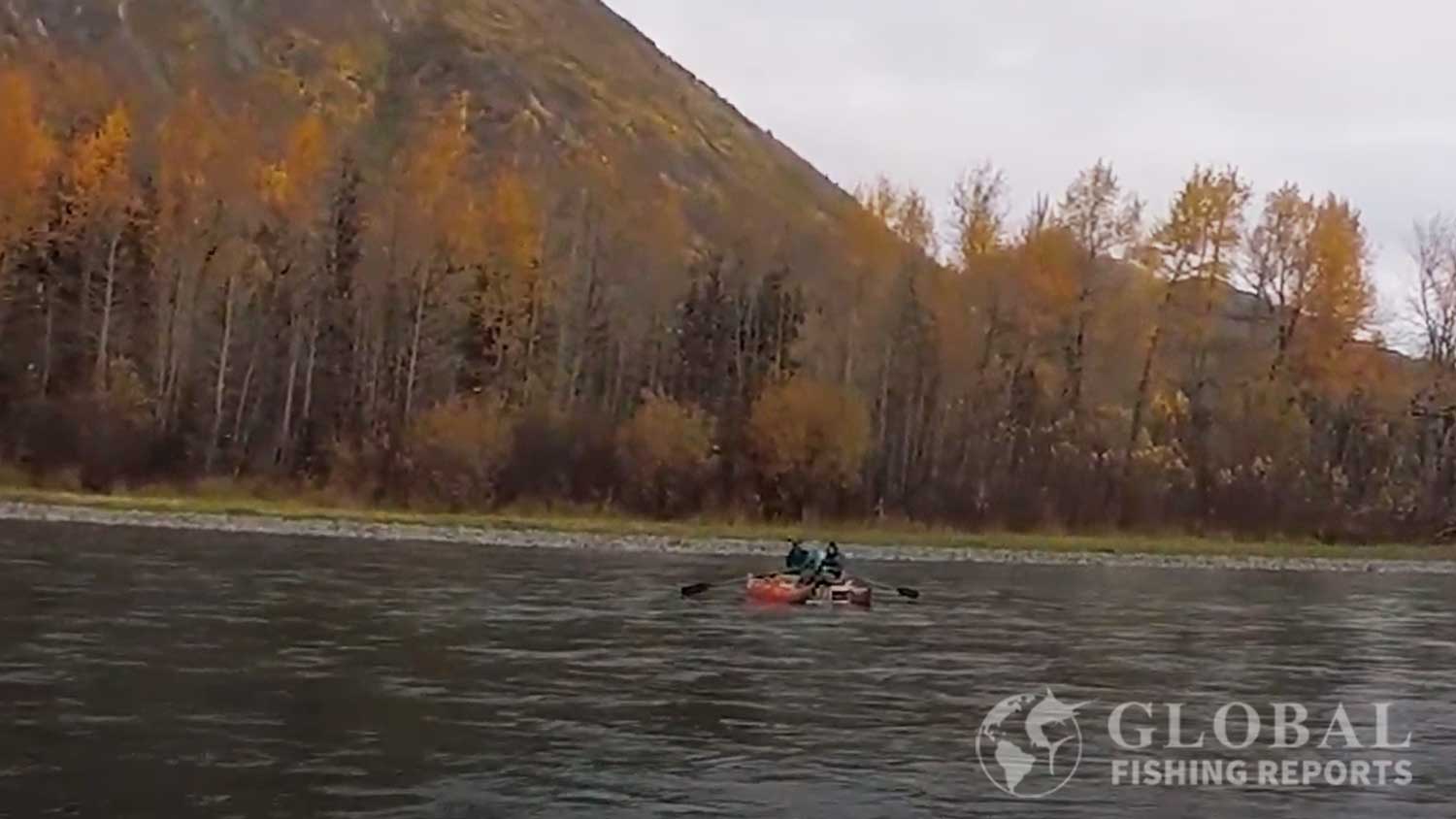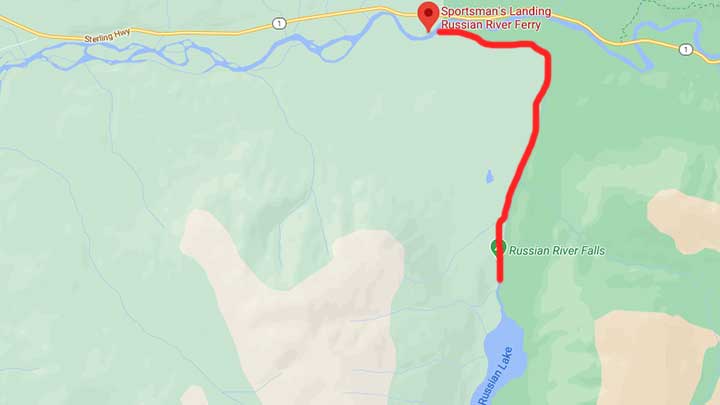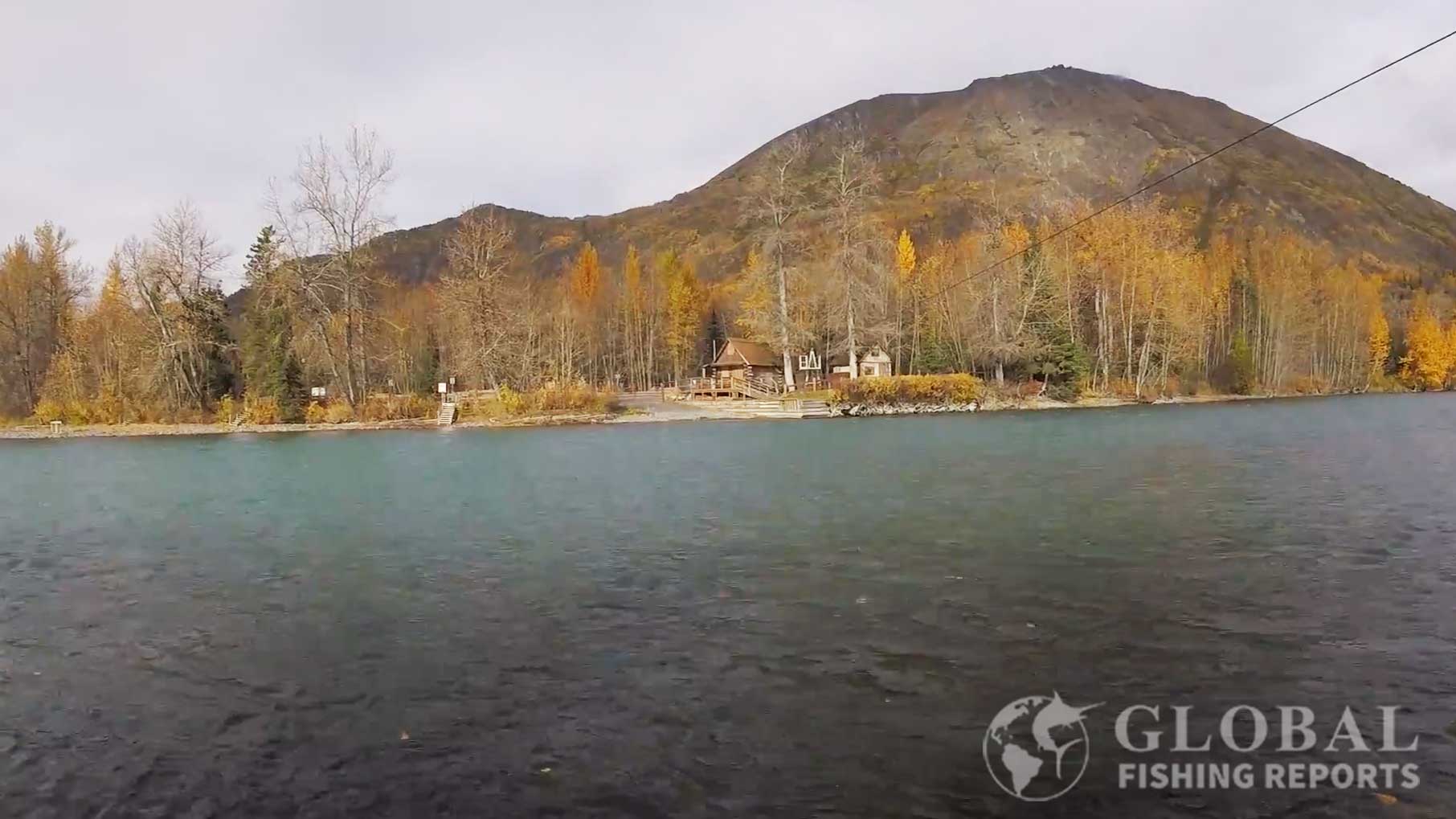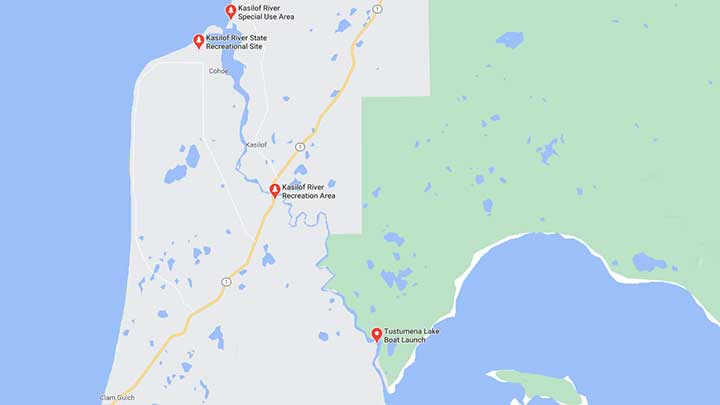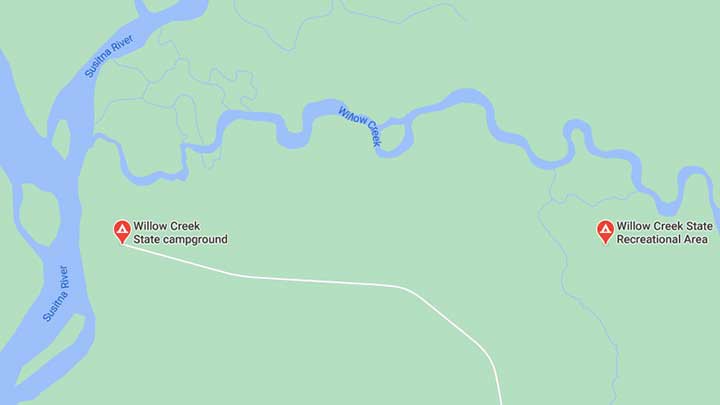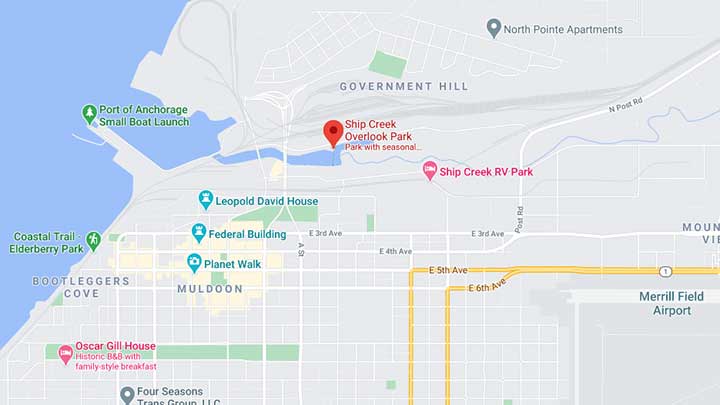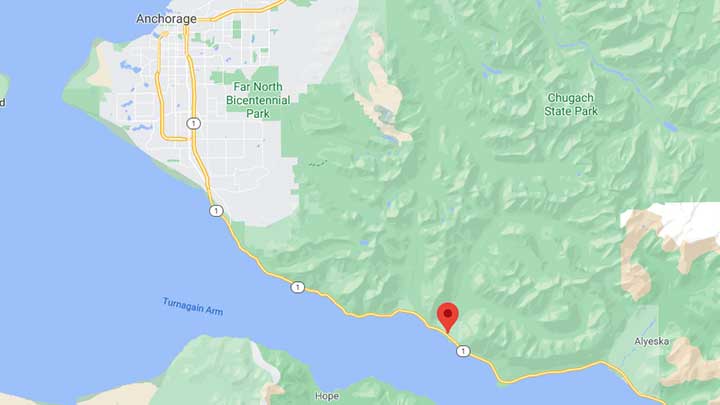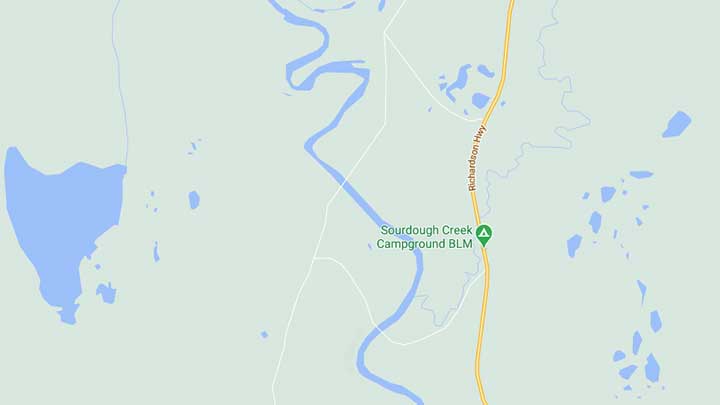There are five different types of Pacific salmon which can all be caught from a boat or from shore. The techniques and gear to use vary depending on the location and type of salmon being targeted. In this guide, I’ll share everything I’ve learned about trolling for salmon, mooching for salmon, and fishing for salmon in rivers and streams based on my years of experience.
Catching salmon is very fun because they fight hard and are great fish to keep and eat. The west coast of the United States is full of wild salmon that run from the San Joaquin river system in California near San Francisco up to the northernmost regions of Alaska.
There are five types of salmon and each type has two names. The salmon types are king or chinook, sockeye or red, coho or silver, chum or dog salmon, and pink or humpy.

In Sitak Alaska and Juneau Alaska, I ran salmon fishing charters where trolling and mooching techniques were used to catch salmon from a boat. I also have fished for salmon in streams in Sitka, Juneau, and the Kenia Peninsula south of Anchorage. This article will focus on catching the five species of pacific salmon. If you are fishing for freshwater salmon check out the article I wrote on catching salmon in the great lakes. The fishing techniques are very similar regardless of where salmon are being caught.
Effective Salmon Fishing Methods
Trolling for Salmon
The most consistent way to catch salmon is to troll offshore. Trolling covers the most water and the lines can be set at different depths to help cover the entire water column. Most commercially caught king and coho salmon are caught with salmon troller boats. Commercial trollers use the same lures and baits but set out about 100 lures rather than one per angler on a recreational fishing boat.
When trolling, it’s important to:
- Use downriggers to get your bait to the proper depth
- Set up multiple lines at different depths to locate fish
- Employ flashers to attract salmon from a distance
- Vary your trolling speed between 1.5-3 knots depending on the species
Trolling Rig: Flasher with a Hoochie
First, we are going to go over the best trolling lures which are used when fishing for salmon from a boat. The most widely used lure when trolling for salmon is a flasher with a hoochie. This works well even without a baitfish added to the hoochie. Baitfish like herring can be added for scent but does not need to be rigged to spin. The motion of the bait on the flasher is plenty of action. When bait ran without a flasher it should be rigged to spin.
When salmon feed they roll from side to side. The flashers rolling motion looks very similar to the salmon feeding motion and attracts fish. When salmon see this flashing motion they think that a fish is feeding and come investigate. The hoochies should be placed on a 40-60 pound leader. I set the leader length to 30 inches for both king salmon and coho salmon. This leader length is from the back swivel on the flasher to the start of the hoochie. A 30-inch leader would be considered short for king salmon. Most people say to use a leader of 36-46 inches for king salmon and 24-34 inches for coho salmon. Some people talk in overall leader lengths that go to the end of the hoochie. Add 4 inches to the lengths I provided to get overall leader lengths.
Hotspot Flasher Purple Haze UV
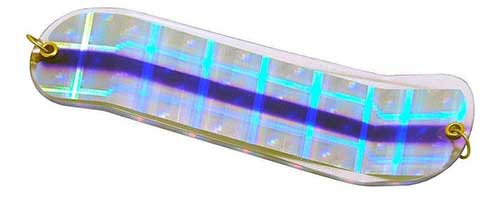
Buy from Amazon
Hotspot flashers are my favorite salmon flashers. This is an 11-inch flasher with ball-bearing swivels. Purple haze works great for king salmon and chum salmon. On bright sunny days, these have a fantastic reflection in the water. King salmon often have a purple shimmer on their upper backs. Match a purple flasher with a purple and pink hoochie and you have one of the best flasher hoochie color combos. This color works best in water depths less than 100 feet. Salmon can actually see further on the UV light spectrum than humans. This UV color that humans can not see would be another shade of purple. This may be why purple works so well at catching salmon. The ability to see light further on the UV spectrum is said to help salmon feed in dark and murky conditions.
I know commercial trollers like using this purple flasher with pink and purple 2.25-inch mini hoochies also called mini sardines for chum salmon fishing. When fishing for chum salmon the trolling speed should be slow so the flasher drifts side to side not actually making full rolling motions. A good speed is usually around 1.5 knots. The more flashers the better for chum salmon as they travel in large schools and you are trying to get the school to follow the boat.
Boone UV Salmon Hoochie
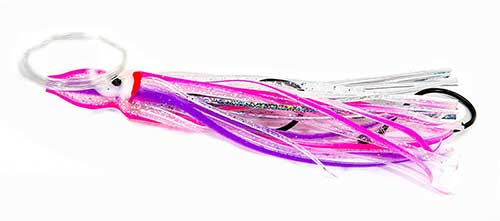
Buy from Amazon
This pink and purple Boone hoochie squid bait is 4 3/4 inches long and comes with a double hooked snell-tied leader. This is a great hoochie that looks like squid or sand lance baitfish. It comes pre-rigged with a double hook leader which is nice for people unsure how to make salmon leaders. Double hooks help the bite-to-catch ratio. When using downriggers the line releases from the clip and there is slack in the line. Having two hooks helps the bait stay in the fished mouth until the tension is brought back on the line.
The other way to rig a hoochie is with a barrel swivel, beads for spacing, and an open eye hook that attaches to the swivel. This single hooks leader works but having two hooks is better than having one hook.
Black Flash Flasher
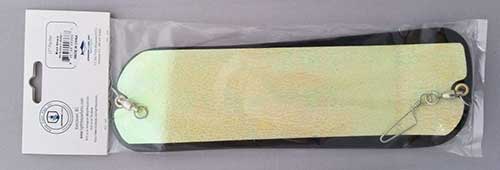
Buy from Amazon
This is an 11-inch flasher with a glow black jelly color pattern. Both sides have shimmer tape. The overall flasher is black. This is my favorite king salmon flasher color patterns to run on cloudy or rainy days. I also run this flasher as the deep flasher when stacking. Typically it is set anywhere from 80-240 feet in depth. For deep flashers over 80 feet deep I typically run this color or all chrome.
Behind this flasher, I like to run a green haze hoochie or the Ultra-Violet Ace High Fly.
Boone UV Green Haze Hoochie Rig
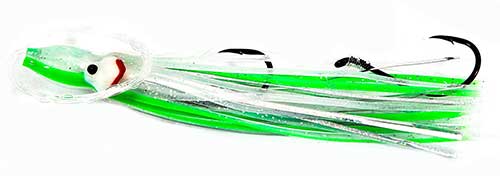
Buy from Amazon
The Green Haze UV hoochie is 4 3/4 inches in length. It comes with double snell tied hooks that come set up and ready to go fishing. The double hooks make it so the salmon is much more likely to get hooked on a short strike.
Blue and Chrome Salmon Flasher

Buy from Amazon
This salmon flasher is 11 inches in length. The blue and chrome flasher is what I use for depths of 100 feet and higher. The color blue shows up deep in the water. For flasher and lures colors it is important to realize that colors disappear when traveling deeper in the water column. Colors disappear in this order, red, orange, yellow, green, blue, and then purple. All colors disappear after 100 feet so you are better off using black, chrome, or glow flasher and lure color patterns.
Goldstar Twinkle Skirt
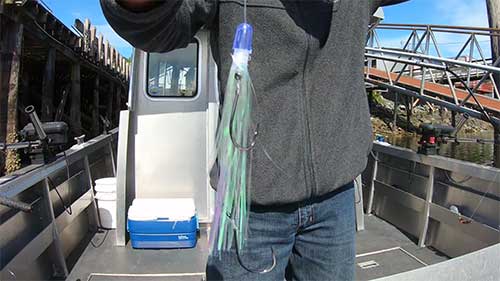
Buy from Amazon
This twinkle skirt is 4.25 inches long. The best color is Mother-of-Pearl. A twinkle skirt serves two purposes. First, it adds thickness and flash to the hoochie. Second, the plastic head spaces the hoochie rig further up on the hooks. With this added spacing the second hook hangs just outside of the skirt. This makes it so that if a salmon short strikes that back of the bait it will still get hooked. These come in packs of ten and there are multiple color options. This twinkle skirt by itself looks like a fly and would likely catch fish but hoochies are typically placed overtop.
Silver Horde Goldstar Hoochie Squid Salmon Bait
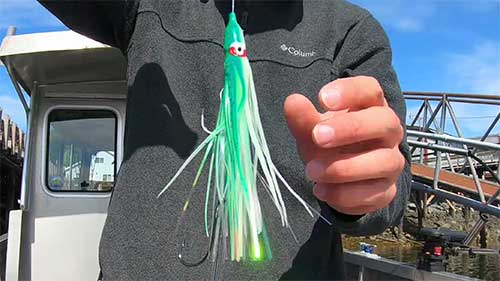
Buy from Amazon
The Goldstar hoochie comes in a 5-pack and is 4.25 inches in length. The best color is the green glow. These hoochies look awesome when placed over the Mother-of-Pearl twinkle skirt. This color works great behind any color flasher and at any depth of water. Typically I use this hoochie behind the blue and silver flashers.
The video below shows how to troll for salmon using downriggers. It may seem like basic information but little tricks can get bait and the right depth with the best presentation. These tips can help put more salmon in the boat. Check out the best downrigger page for more information about salmon fishing with downriggers.
Trolling Rig: Flasher with Herring
The how to use downriggers video above shows the best way to run herring baits with a flasher. The flasher is attached about two feet behind the downrigger ball. The bait is placed on a release clip about two feet above the ball. The line is set about 6 feet back so it sits about three feet behind the flasher. This makes it so the flasher can attract fish and the bait has the best action. When a fish bites the line releases from the clip and fish can be reeled in without having to reel in the flasher.
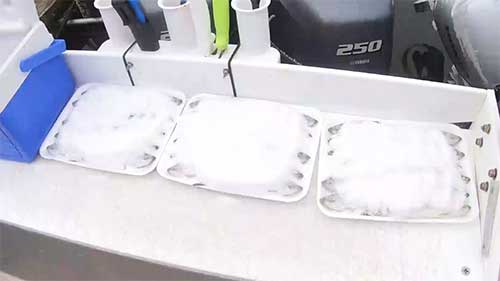
The picture shows three green-labeled herring flats. Each flat has about 12 herring. Each morning these are set out and salt is poured over the herring. This was extra -fine brine salt but any salt will work. Then spray saltwater over the flats and give them a few minutes to soak. Then place the bait in a small cooler. Some people add saltwater to the cooler but I do not. The salt helps to brine the bait which keeps it firm. Without salt, the bait turns soft and will not last as long on a hook. If the bait says cold salt is not really even needed. It does not take much effort to brine the baits so it is good to do when possible. Do not use fresh water on the bait as it might have chlorine and minerals that make the bait smell unnatural to the fish.
Herring Salmon Bait
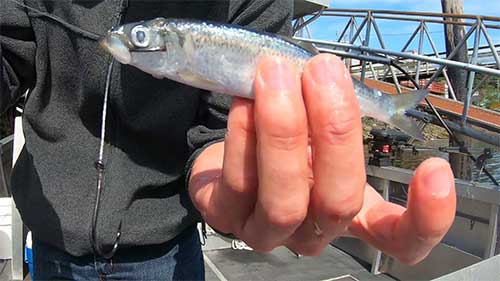
The best bait for salmon is definitely herring. All-day every day herring will catch salmon. People hook up herring as plug-cut herring or whole herring. As long as the bait is spinning it will catch fish. Using the whole herring is faster and easier. In the downriggers video and the how-to mooch for salmon video, I show the best and fastest way to rig herring baits. When fishing blue water for pelagic fish like mahi-mahi and tuna if a bait spins you will not catch fish. With salmon, it is the opposite and if the bait does not spin it will not catch as many fish.
Herring is rigged the same way whether it is being used for trolling or mooching. The front hook is placed through the membrane under the mouth and then through the middle of the head on the other side. The trailing hook can hang free or be placed through the back just behind the dorsal fin. When running bait connected to a flasher with a hoochie place the front hook in the lower jaw and out the nose then weave the trailing hook in the back and then let it come out and sit free. This makes the bait not spin as much because the flasher will be rolling and creating plenty of action.
Solid Tie Mooching Rig

Buy from Amazon
Shop Bass Pro Shops
A 40-pound solid tied mooching rig is perfect for herring and hoochie rigs. The hooks size will be 5/0 and 6/0. I like using both hooks in the 5/0 size but that is not how these rigs come. Do not get slip tie rigs. The bait is pulled from the front and the front hook will slide to the back before a fish bites. Maybe slip tie rigs work better for plug cut herring I am not sure but do not get slip tie rigs when using a whole herring.
Chrome Mylar Pro-Troll Flasher
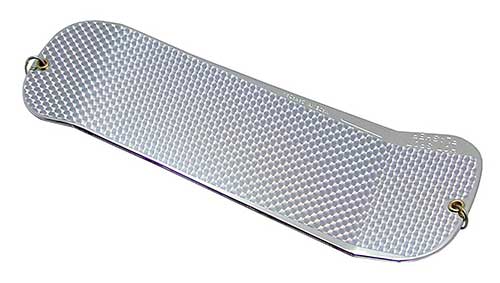
Buy from Amazon
Shop Bass Pro Shops
This is an 11-inch chrome mylar Pro-Troll flasher. When setting the deepest line, solid chrome is my go-to flasher color. This is the flasher that is attached to the downrigger ball that I try and get as close to the bottom as possible without getting snagged on the bottom. Sometimes the flasher comes back scraped up from hitting on rocks and gravel on the bottom. The Silver Horde gold star piscator metal chrome flasher is the one I was using in the downrigger video. This flasher is sometimes used by commercial fishermen.
Any large silver-colored flasher will work. Note that to get to the bottom the downrigger usually needs to be set about 10 percent further down compared to the fish finder depth. At 100 feet the downrigger line counter can typically be set to about 110 feet without touching the bottom. Only get close to the bottom when it is flat and not rocky. Otherwise, it will be difficult to track and gear might get lost.
When using bait above and independent of the flasher it can be smart to drop the bait back when a fish bites but does not get hooked. If the line comes out of the release clip and you know the fish is not then put the reel in free spool. Sometimes the salmon comes back and takes the bait. Most people are better off reeling as fast as possible though because when salmon bite they swim up toward the surface. Not reeling will lose more fish than will be caught dropping the line back. If you do it enough times and get on the reel right away you know if the salmon is there and dropping back can give a second opportunity at the fish.
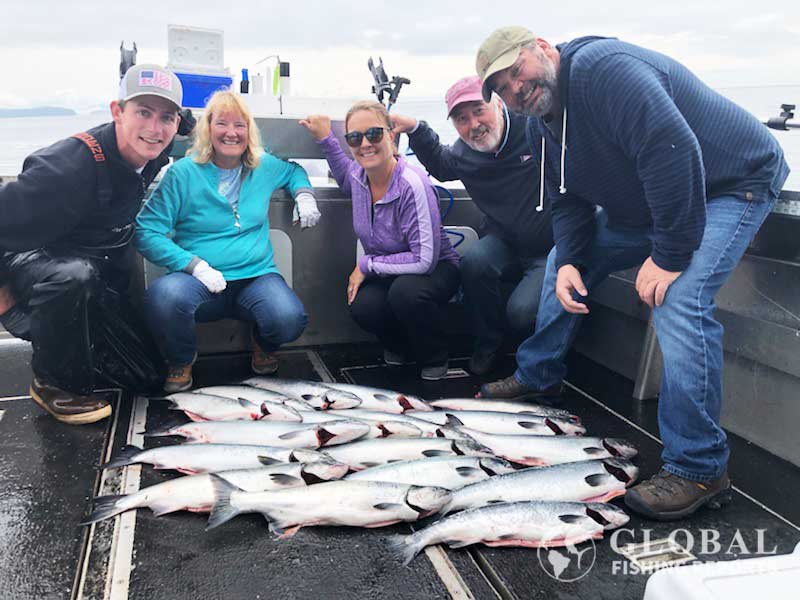
In the picture are silver salmon caught on a half-day charter in Sitka Alaska in early August. These were caught both trolling and mooching but mostly mooching.
Trolling Spoon: Silver Horde Coho Killer

Buy from Amazon
Shop Bass Pro Shops
Coho killer spoons work great when trolling. This spoon works with a short leader. The leader should be about 30 inches from the back of a flasher to the start of the spoon. With heavier spoons running a 4-5 foot leaders behind the flasher works great because the spoon will have great independent action. Smaller flashers can be used when coho fishing which makes it faster and easier to reel fish in.

Trolling Spoon: Blue Coyote Salmon Lure

Buy from Amazon
Shop Bass Pro Shops
The blue Coyote spoon comes in 3.5 and 4-inch models. The 3.5-inch is similar to a coho killer size spoon and goes good on a 30-inch leader behind a blue and chrome flasher. The 4-inch model can be placed behind a flasher with a slightly longer leader around 36 inches. This spoon can also run behind the downrigger ball on a release clip. The spoon would be about 10 feet behind the ball. Running the spoon about 10 feet past a stacker clip-on at mid-depths on the downrigger line works great as well.

This was the biggest salmon caught on my boat last season in Sitka Alaska in late June. It was 40-inches long and likely weighed over 30 pounds. The king salmon hit while trolling near the bottom in 120 feet of water and we did not get the line tight with the fish until it was near the boat. It then took several very fast runs around the boat. The first time I netted it there was a hook in the net and the salmon rolled off the net and we almost lost the fish. Luckily the line did not break and we caught the fish on round two of netting.
Trooling Spoon: Dream Weaver Salmon Spoon
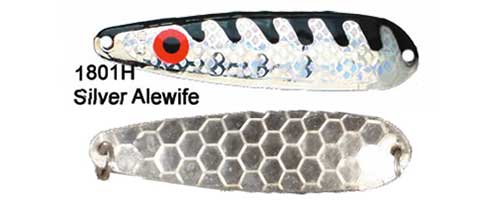
Buy from Amazon
Shop Bass Pro Shops
This silver alewife spoon is 3-3/4 inches long. Dream weaver spoons outfish all other spoons on the great lakes and work great in the ocean as well. The large honeycomb stamped steel looks fantastic. This black and silver is a great color option as it looks like herring. These spoons are set about 10 feet behind the downrigger ball without a flasher. These work good for coho but great on king salmon.

These are two nice kings salmon caught last season in Sitka Alaska in mid-July. One was caught while dropping the downrigger in the middle of the water column. The other was caught near the bottom in about 150 feet of water on herring. There was a school of these jumbo kings that stuck around this area for a few days.
Trolling Upper Water Coulum: Jointed Rapala Bright Orange

Buy from Amazon
Shop Bass Pro Shops
An orange J-9 or J-11 jointed Rapala works great for trolling on a flat line without weight 200 or more feet behind the boat. This lure swims about 12 feet below the surface and works great at catching coho salmon that are swimming near the surface. The trolling speed has to be over 2.4 knots for this lure to work well. When trolling with spoons for coho salmon at a higher troll speed this lure stays straight out the back and tangle-free of all the other lines and catches fish near the surface. When fishing flat lines it is nice having a line counter reel to know the distance the line is set behind the boat.
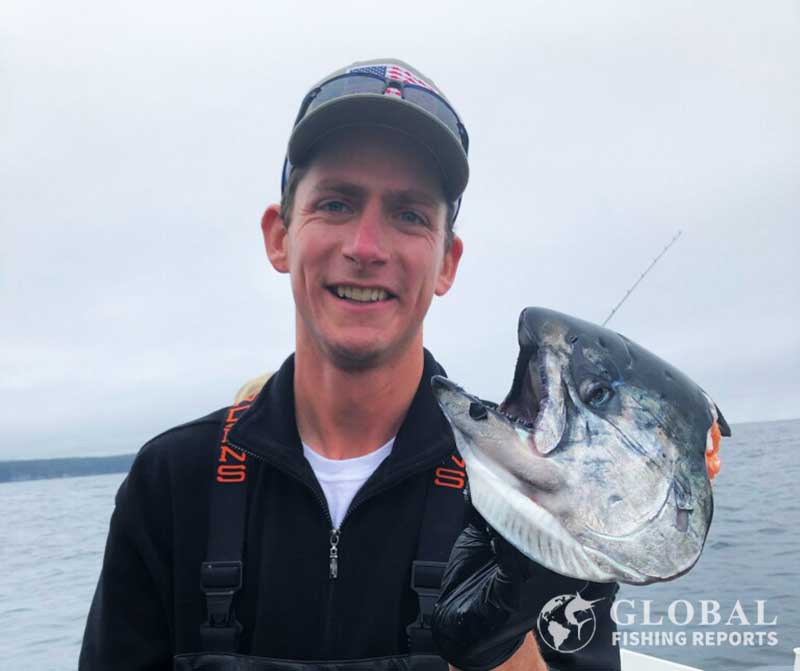
Sea lions only took salmon from our lines a few times last year. This was one of those times and it happed when reeling in a nice king salmon. All that was left was the head. The fish was fighting hard and then starting pulling even harder. We knew it was a shark or a sea lion but saw the sea lion after. The lady reeling in the salmon was not happy with the sea lion.
Trolling Fly: Ace Hi Fly
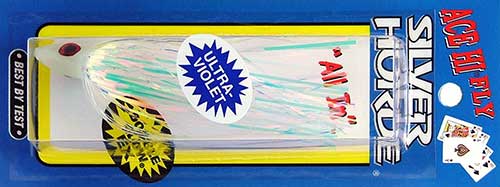
Buy from Amazon
Shop Bass Pro Shops
The Ace High Fly is 4-1/2 inches long and has a double glow head. The best colors are ultra-violet and cop-car. These baits look very similar to the sand lance shown below. When the salmon I am cleaning are filled with sand lance I use a flasher with a fly. The best way to rig them is to slide the fly on a sold tie mooching leader. Cut the leader 31 inches long to the front hook and tie the leader to the flasher.
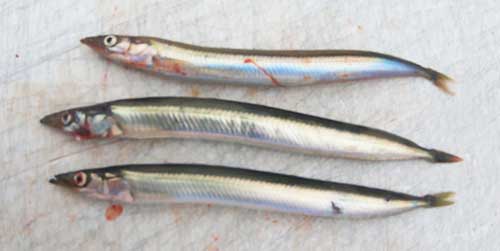
The sand lance baitfish above were taken from the stomach of a king salmon. Sand lance can swim in large schools and is typically found near the bottom of sand flats and gravel flats. Finding gravel flats is key to catching king salmon. In the first two months of the season, there were very few herring around and king salmon were mostly feeding on sand lance.
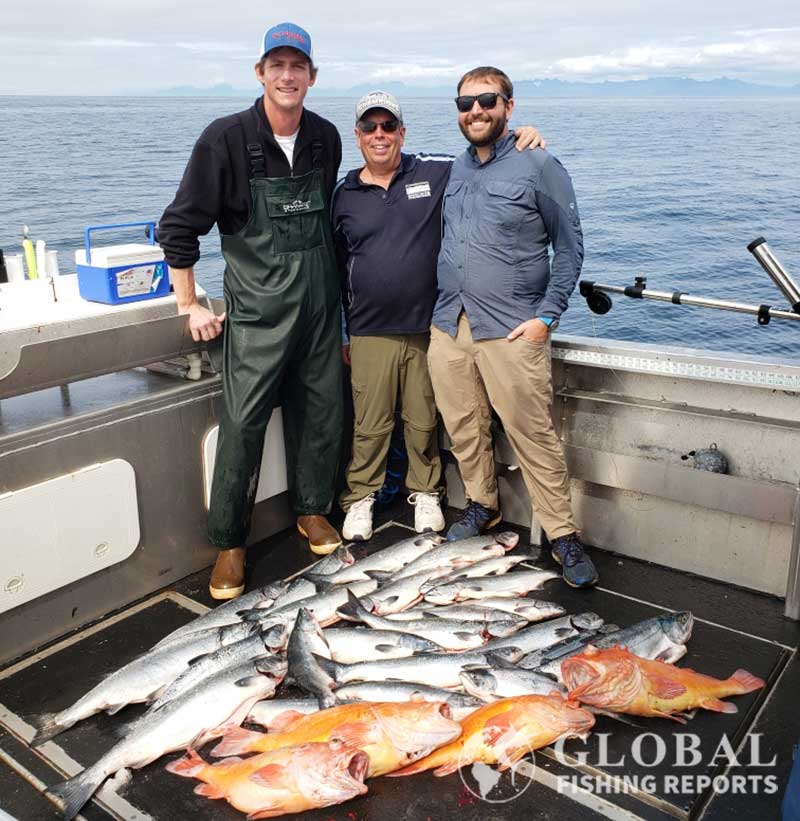
This was a day of fishing in mid-July in Sitak Alaska. There were lots of pink and silver salmon around. The orange fish are yelloweye rockfish. The salmon was caught while mooching on anchor and mooching while drifting.
Trolling Hoochie: Mini Hoochie
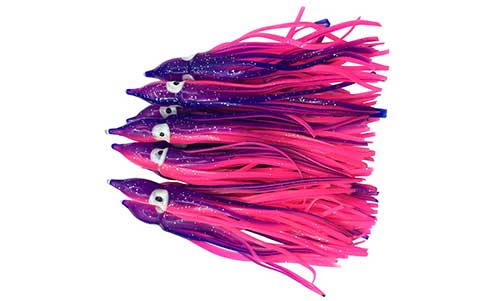
Buy from Amazon
Shop Bass Pro Shops
These purple and pink squid baits are 2.3 inches long. These are similar to gold star mini sardine baits that are 2.25 inches in length. These baits go amazing with the hotspot purple haze UV flasher. These baits work well for king and silver salmon but are typically used for targeting chum salmon. As I mentioned above when fishing for chum salmon these are trolled slowly with as many flashers as possible.
Ace High Fly junior
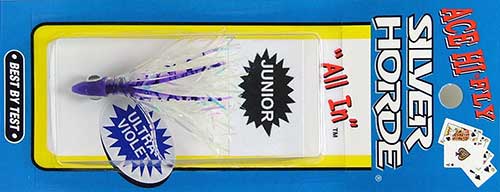
Buy from Amazon
This Ace High Fly Junior is 2.25 inches long and has a double glow head. Salmon often feed on small shrimp and squid. Sometimes matching the hatch is needed and small lures will catch more salmon. This is especially true for sockeye salmon that only feed on smaller baits. Occasionally sockeye salmon are caught on full-size hoochies but if you know sockeye are around try a junior fly.
Gold Star Tailwagger
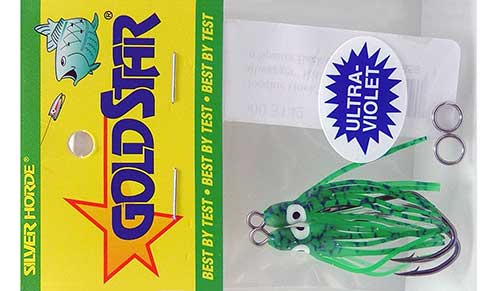
Buy from Amazon
The gold star hoochie squid is a 1-3/4 inch micro squid. These come with split rings and can be placed on the back of spoons. The micro squid also works well by themselves behind a flasher for coho, chum, and sockeye salmon.

The salmon and halibut were caught in early August in Sitka Alaska. The king salmon were caught and released only for a few weeks in August due to limit closure but we caught plenty of silver salmon and halibut. We caught some oversized halibut on this trip as well.
How to Mooch for Salmon
My favorite way to catch salmon is by mooching. When mooching for salmon a herring bait is sent down 100 to 200 feet with a 6-ounce weight. The line is then reeled back up. This is similar to vertical jigging and salmon bite on the way down or on the way up. When mooching for salmon it is also common to catch halibut and rockfish.
The video below shows how to mooch for salmon. If there is no current the fishing line needs to be pitched out so that when the rig sinks the leader does not wrap around the mainline. A small amount of tension needs to be kept on the spool when the line is sinking or the salmon fishing reel will get bird nested. The line is set down from 100 to 200 feet typically 150 feet and is then brought back to the surface. The saying goes ” the more you turn, the more you earn”. This points out that more fish are caught when reeling up continuously. On some trips, one person has there a limit of six silvers and a king and other people only catch one fish. It comes down to getting the bait deep and continuously reeling it back up.
If there is a strong current keeping the line at an angle it will not tangle the bait does not always have to be brought the entire way up. If all the fish are being hooked between 80 feet and 120 feet the line can be reeled up to 60 feet and then back to 150 feet. This keeps the bait where the fish are being caught. Every few drops the bait should be checked to see if it has been chewed up or stolen. When the salmon are biting the bait is usually torn up or stolen every drop.
If anything unusual is felt during the drop it is likely a bite and the slack in the line needs to be reeled in as quick as possible. Even when fish bite when retrieving line the reel speed needs to be increased. Setting the hook by lifting the rod does not work. This is because when salmon feed they swim up. A fish that bites at 100 feet may be at 60 feet in a few seconds. Lifting the rod is not going to get the slack out of the line. The reel needs to be turned as quickly as possible.
Large kings salmon swim toward the surface the fastest after biting. For most of the biggest fish of the year people felt a small bite and did not get the line tight until it was super close to the boat. Once the king salmon sees the boat and realizes it is hooked it takes off like a rocket though.
When netting the fish reel the tip of the pole all the way to the slider and lift the rod back. Once the fish is netted be careful with the swinging weight. Grab the weight with your had or reel the slider back to the tip of the pole so it is not swinging. People are always excited about the caught fish and overlook the swinging weight.
Salmon Mooching Rig
Mooching for salmon is my favorite way to catch salmon. It is also the best way to catch the most fish when there are schools of salmon in the area. Mooching is not something most people do on a half-day fishing chatter because it takes a full day with fish biting to really get the hang of it. This can be overcome by helping people cast, having clients reel continuously, and being good at untangling lines. It is worth the extra work though because most people love mooching for salmon!
This mooching rig can also be used when trolling. The line is set out 50-200 feet behind the boat. This puts the bait about 10-30 feet below the surface. One trick is that when a fish bites on the downrigger line the flatline reel can be put in the free spool mode to drop the bait deep. About 1 in 5 times this leads to another salmon being hooked.
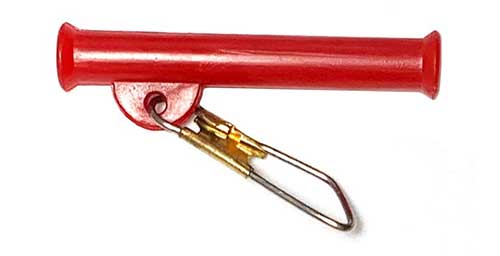
Buy from Amazon
Shop Bass Pro Shops
The red slider is 1-1/2 inches long and is placed before the swivel on the mainline. A 6 or 8-ounce round weight is placed on the slider clip. This slider comes in black or red and either color works well.
Six Bead Swivel

Buy from Amazon
Shop Bass Pro Shops
The six-bead swivel connects the mainline and the leader. A barrel or crane swivel would work here also but most people use a six-bead swivel.
Salmon Mooching Weight
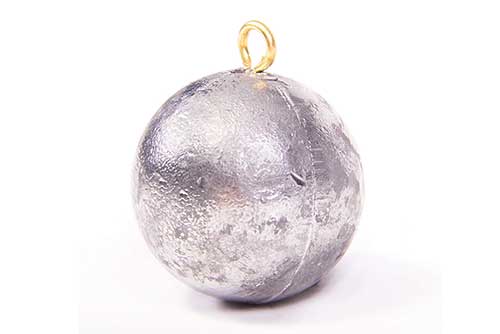
Buy from Amazon
Shop Bass Pro Shops
A 6-8 ounce weight is best for mooching. A 6-ounce weight is typically used because it is easier to reel in. An 8-ounce weight is needed when the current is very strong. The old-style mooching weights were banana weights with the six bead swivel on one end and a snap swivel on the other. This setup was not as easy to set up and put away each day because the leader stays with the weight.
Salmon Mooching Rig

Buy from Amazon
Shop Bass Pro Shops
The mooching leader comes with 5/0 and 6/0 hooks that are tied with two solid tie snell knots. These same rigs come with a sliding top hook but that is not what you want to get. Make sure the solid tie option is selected.

The herring bait is rigged so that it spins. The front hook is placed below the mouth and then through the side of the head on the other side. The trailing hook can hang free or be placed in the back of the herring behind the dorsal fin.
Salmon Jig: Point Wilson Dart
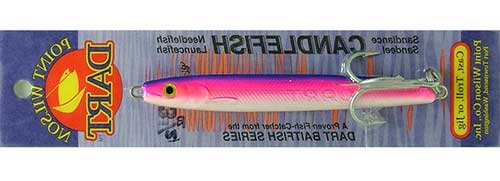
Buy from Amazon
Shop Bass Pro Shops
The Point Wilson Dart candlefish salmon jig comes in sizes from 1 ounce to 6 ounces. The Point Wilson Dart company makes some of the most versatile salmon jigs. The candlefish jigs look very similar to a sand lace baitfish which is a favorite food of king salmon. Lifting this jig 5-feet of the bottom and back down is a great way to target king salmon. There is also a Point Wilson’s Dart anchovy that is thicker that works well when jigging in more than 100 feet.
Salmon jigs are also going to catch rockfish, halibut, and lingcod. Jigging is a very popular fishing style in the pacific northwest. Two other popular jigs are buzz bombs and crippled herring jigs. I was not a big believer in salmon jigs until I saw a boat next to me catch their limit of king salmon in about 10 minutes and were gone. Trolling along for two hours in the same area we only caught a few. That is how it goes though, somedays people jigging and mooching catch more fish than the trollers other days the trollers catch more fish.
River and Stream Fishing for Salmon
In streams, the techniques vary widely from flies to spoons and large spinners. Stream and river fishing for salmon is awesome because it is a peaceful environment with a high concentration of fish. Hiking and exploring remote areas can be as much fun as catching fish.
When fishing rivers, consider these approaches:
- Use single-hook spinners in areas where regulations require them
- Try trout beads placed 2 inches above the hook (secured with a toothpick)
- Employ drift boats to access remote fishing spots
- Select files that mimic local baitfish or salmon eggs
It is important to note there are lots of different rules and regulations about when, where, and how you are allowed to fish for salmon so make sure to read the local regulation books and notices before going fishing.
Spinners with Single Hooks: Mepps Number 5
Next, let look at the best salmon lures for rivers and streams. Spinners, spoons, and trout beads all work great at catching salmon from the shore. Getting to good fishing spots can be the most difficult part of fishing for salmon along streams and rivers. Getting a good pair of fishing waders is definitely a good idea. Hiking to remote areas is often an advantage because there will be fewer people fishing in the area. Some people use drift boats to get to good fishing spots along the river.
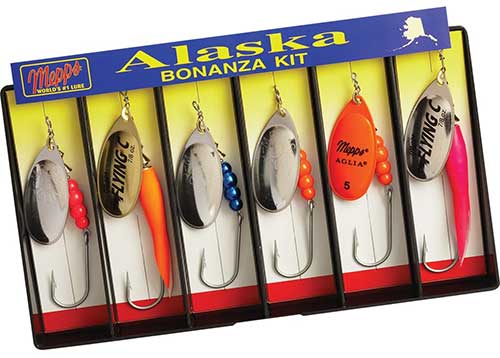
Buy from Amazon
Shop Bass Pro Shops
Orange and pink Mepps #5 single hook spinners work amazing for catching salmon. Spinners work great at catching salmon near the mouths of streams or in deep rivers. Mepps spinners are typically had to find with single hooks which are required for most salmon streams.
Spinner: Blue Fox Nimber 5 Spinner
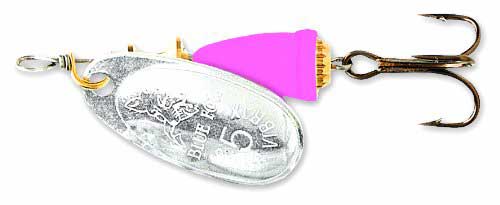
Buy from Amazon
Shop Bass Pro Shops
Blue fox spinners are also known for catching salmon from the shore. Personally, I have more luck with Mepps spinners. These spinners typically come rigged with treble hooks but also come with an open-eye single hook. The treble hook can be cut off and the single hook can be put on with a pair of pliers.
Wicked Lures Blade with Hooching

Buy from Amazon
Shop Bass Pro Shops
Wicked lures are rigged on 20-pound leaders 6 feet in length with 1/0 Gamakatsue red hooks. These are similar to spinnerbaits and are meant to be fished in rivers and streams. Weight is typically added to the end of the leader and these baits are slowly retrieved upstream. Wicked lures are new baits that have only been on the market for a few years.
Casting Spoon: Blue Fox Pixee
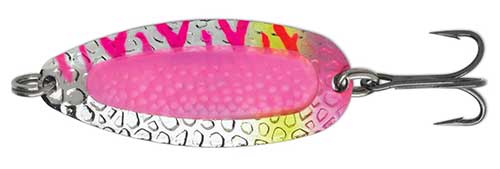
Buy from Amazon
Shop Bass Pro Shops
A pink Blue Fox Pixee spoon is a great spoon for casting from the shore near the mouth of a river or into the open ocean. This is a heavy 7/8 ounce spoon and can cast further than spinners which is a huge advantage. Sometimes fish are breaking the surface just out of reach of spinnerbaits and this heavier lure can get the bait further out where the fish swim.
Salmon Fly: Dolly Llama
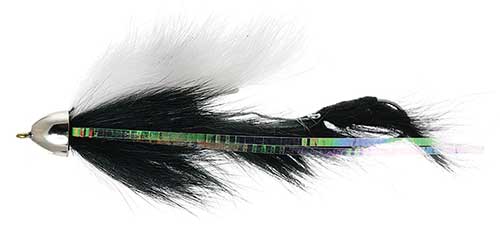
A Black and white dolly llama fly works well for coho salmon. The pink, purple, and green dolly llamas are also popular color options. Make sure that weighted flies are allowed in the area that is being fished.
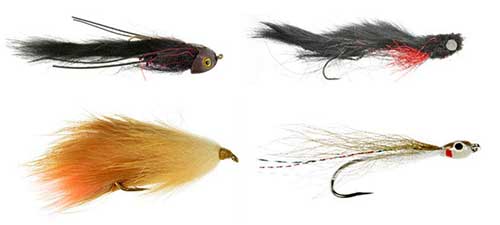
Buy from Amazon
Shop Bass Pro Shops
This fly collection comes with 12 large flies made for catching salmon and trout in Alaska. The flies include Mr. Hankey, Morrish Mouse, Black and White Dolly Llama, Bunny Leech, Hopscotch Sculpin, Leech, Black Fish Skull Sculpin, Black S’s, Sculpin Leech, Sculpzilla, Moal Rhoid Flesh Leech, Flesh Fly, and Thundercreek. Bass Pros Shops has a similar 6-pack of salmon flies.
Salmon Fly: Russian or Coho Fly

The fly above is a Russian fly also called a coho fly. Someone I met fishing the Kenia peninsula gave me this fly and said it works great for catching sockeye salmon and silver salmon.
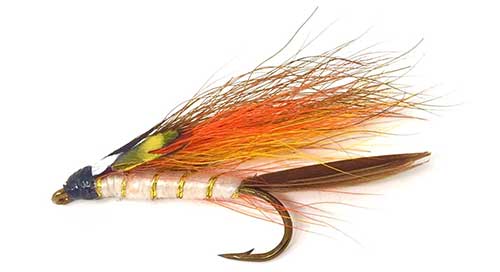
Buy from Amazon
The feeder creek salmon fly is similar in appearance to the coho fly. It comes in three sizes 8, 10, and 12. Four of each fly are in the set for a total of 12 flies. These flies are going to be smaller than the coho fly I showed above but should still work for catching sockeye salmon.
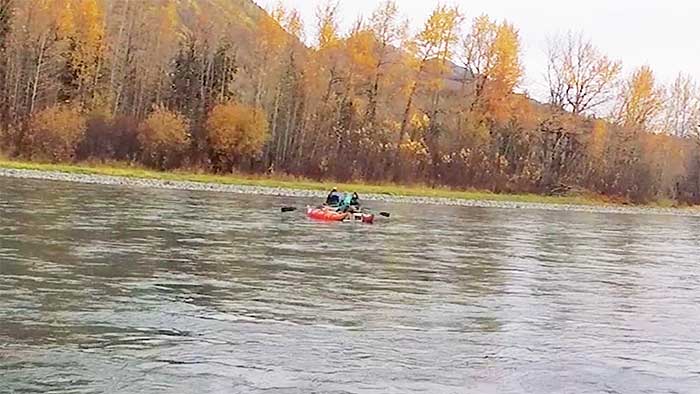
The drift boat is fishing for salmon in the Kenia Penisula in early October. The anglers fish while drifting and stop along the way and fish from the shore. Before floating down the river a car needs to be placed downstream or a ride needs to be arranged to get back to the starting point. Luckily many rivers follow along the roadways. It was late in the season but there were still bright silver salmon around not very many people.
Trout Beads for Salmon
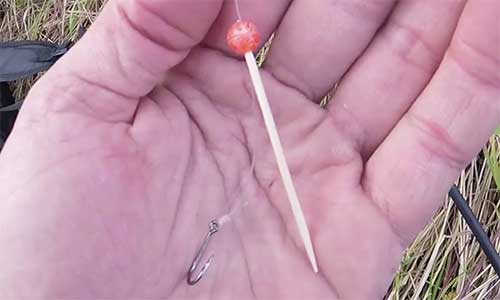
The picture above shows how to set up a trout bead rig. Regulations in Alaska say that the bead must be 2 inches above the hook. The bead is held in place with a toothpick that is then broken off. This is way easier than trying to use rubber bands to hold the bead in place. Real salmon eggs are illegal so these beads are the best option. One great thing about trout beads is they can be fished in fly-only streams, even when a spinning reel is being used. A small foam float can be used to suspend the trout bead just off the bottom.
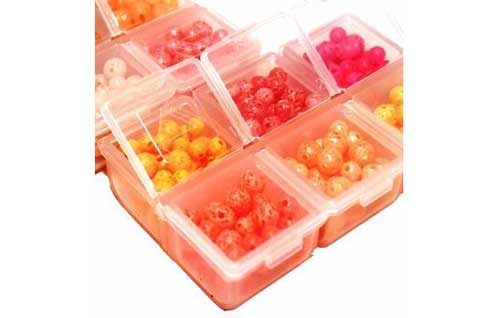
Buy from Amazon
Shop Bass Pro Shops
Trout beads work great to catch rainbow trout, Dolly Varden, and salmon. Salmon eggs take from 6 to 20 weeks to hatch depending on the salmon species. The eggs are changing color and size throughout this process. It is good to have several color and size options to match the egg development present in the stream or river. Eventually, the eggs turn into an alevin, fry, smolt, and then become an ocean swimming salmon.
Gamakatsu Octopus Salmon Hooks
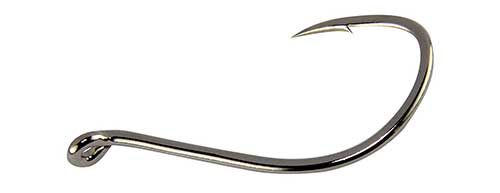
Buy from Amazon
Shop Bass Pro Shops
Size 6 hooks are a good hook size for salmon and trout. Hook color options include black, nickel, blue, bronze, green, red, and chartreuse. Nickel seems like a good color option. The hooks are small but very strong.
Toothpicks
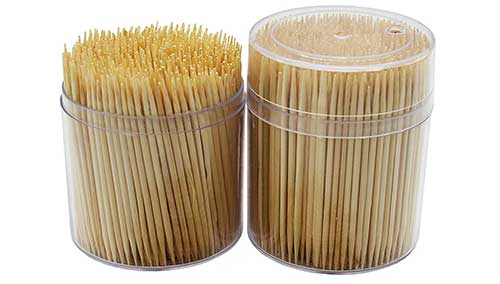
Buy from Amazon
Toothpicks work to hold the trout bead in place. Rubber bands can also be used as well but toothpicks are the easier method. Each container holds 500 toothpicks for a total of 1000 toothpicks.
River Mouth Tactics
The mouths of rivers concentrate salmon as they prepare to spawn:
- Cast heavy spoons that can reach fish-holding outside the current
- Focus on incoming tide conditions when fish are staging
- Watch for “rolling” salmon that indicate where schools are holding
- Consider using snagging hooks in saltwater areas where legal
Snagging Salmon
Snagging salmon is illegal in streams. However near the mouth of small streams where hatchery salmon come back snagging is a legal and effective way to catch salmon. These salmon were released by the hatchery as fry with the intention of being caught and consumed as food. Some are used again in the hatchery to release more fry during the spring. If these hatchery fish are not caught they will die anyway and go to waste. That is why snagging these fish is legal.
Trebble Hook Snagging Rig
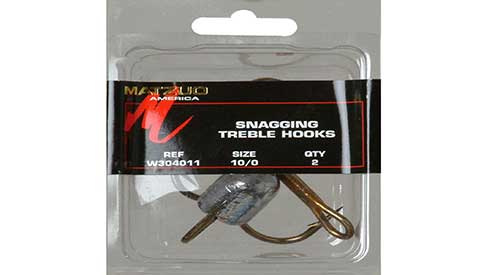
Buy from Amazon
Shop Bass Pro Shops
This pack comes with two size 10/0 snagging treble hooks. Bass Pro Shops also sells similar weighted treble hooks. Snagging treble hooks are only legal in saltwater, not freshwater rivers and streams.
Snagging hooks are typically used near the mouth of small streams where hatchery salmon swim back and forth. The salmon around the hatchery do not have a large stream to swim up and spawn. The fish swim back in forth near the stream entrance where they are released as fry. The fish are ready to spawn and are not aggressive feeders on normal lures and baits. People use snagging hooks to catch 6 or more salmon per day to stock up on fresh fish for the winter. If the fish are not caught they are going to die anyway within a few weeks. Using a snagging hook can be a productive way to catch fish that you intend to keep and eat.
Salmon Handling and Processing
When you catch a salmon you intend to keep:
- Dispatch it humanely with a quick blow to the head
- Bleed the fish immediately by cutting the gills
- Shorty after bleeding the salmon remove the guts, gills, and bloodline
- Keep the fish cool, preferably on ice
- Process it as soon as possible for the best quality
Fish Bat
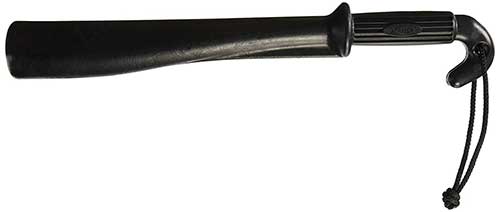
Buy from Amazon
Black AFTCO fish bat. This is a 19-inch 1.3-pound club. When a salmon is caught it is hit on the head with a club. This may seem to be mean or cruel but it is in the best interest of the fish to be knocked out. It is also safer for the angler when removing the hooks and cleaning the salmon. There are also commercial fish gaffs that have a PVC end that works as a club. This allows the fish to be hit in the water and then gaffed.
Salmon Fishing Season
The best time of year to salmon fish varies from early spring to late fall depending on the fishing location and type of salmon being targeted. King salmon season starts first and last year we were catching limits of king salmon in Sitka Alaska in late April. This is before the season technically starts. King salmon are caught in Sitka from late April until early September with the peak season being May and June.
Silver salmon, chum salmon, and pink salmon season start in early July and go until early September, and peaks in early August. Sockeye season is in July and August as well. Each year the fish show up at different times based on water temperatures and the amount of rain. Alaska fish and game has guide charts to show typical salmon season times based on species and geographic location. If you plan to fish in streams, show up in mid-July through August and there will be tons for fish to catch. I personally like fishing earlier when the fish are still bright silver. From a boat, we definitely caught the most salmon in late July through August. It is fishing so catches vary from day to day.
Catching kings in the spring is my favorite time to fish for salmon but most people do not realize is that on a four-hour charter the average number of king salmon caught is typically one or two per boat. On an all-day trip, the limit of one fish per person can usually be caught. During July and August, each person can catch one king salmon and six silver salmon each. However, there are typically fewer king salmon around, and some years it is caught and released only for kings later in the Summer, which varies based on catch rates. Halibut fishing is good all spring and summer.
Salmon Fishing Destinations
The best salmon fishing in Alaska. It may seem far away but it is less than a four-hour flight from Seattle to Anchorage. From Anchorage, it is about a three-hour drive to some of the world’s best salmon fishing in the Kenai River, Russian River, Kasilof River, and Copper River systems on the Kenai Penisula. Literally millions of salmon run up these rivers in July and August. There are not many places on the Alaska coast that is not loaded with salmon. Many people prefer going to small towns or fishing lodges where there are fewer people to deal with and can fish in the most scenic parts of the United States.
Other popular places to salmon fish in Alaska include Ship Creek in Anchorage, Kodiak Island, Homer, Seward, Cordova, Elfin Cove, Juneau, Sitka, Haines, and Ketchikan. Some of these locations have great rivers to fish. Other areas mostly fish in the open ocean. For example, Sitka only has a few streams that mostly have pink salmon. However, the open ocean outside of Sitka is where all the salmon traveling to streams south of Sitka in British Columbia, Washington, Oregon, and California feed before going upstream.
Some fish stay in Sitka and feed for a day and some stay for a year. Salmon are the second fastest growing fish in the world, second only the mahi-mahi. That means when the salmon are feeding the bite can be very good. Once salmon enter the stream they do not feed much. There are just too many fish and not enough food. That is why trolling for salmon in boats can be so effective. Also, the fish caught from boats are bright silver and are the best to eat.
When salmon first enter the stream they are bright silver and great to eat as well. After a few weeks, they start to turn as they spawn and the flesh eventually starts to rot. If it is just a little turned it is still great to eat. If it is bright red, black, or white it is no longer good to eat.
Eating Quality of Different Salmon Species
King salmon are the best-tasting salmon to eat. White king salmon are especially good because of the high oil content. Many people think that all salmon is the same but that is far from the truth. Most salmon that people buy at the store is Atlantic farm-raised salmon. For many reasons, this is the worst salmon to eat. Many bumper stickers in Alaska say”Friends don’t let friends eat farmed-raised fish”.
For Pacific wild-caught salmon king salmon is generally recognized as the best salmon and costs about $40 a pound to purchase at the store. The next best is sockeye salmon also called red salmon which costs about $30 a pound at the store. Silver salmon which is coho salmon is the third-best eating salmon. This is still a great tasking fish and cost about $20 a pound. The bigger the silver salmon the better it usually tastes as well.
The fourth best is chum or dog salmon. This is not a common fish sold commercially but if you catch one it is worth keeping to eat. The fifth and worst-eating salmon is a pink salmon also called a humpy salmon. These fish sell commercially for about 50 cents per fish. This is the salmon that is used in cat and dog food. They do sell cans and pouches of pink salmon for humans to eat. It has so much salt it tastes alright. Pink salmon actually tastes good if they are eaten the same day they are caught. There is an enzyme in the meat that releases and turns the meat to mush and does not taste good after a few days.
The video below shows the best way to fillet salmon. In the video, several monster 30+ pound king salmon are filleted. Filleting techniques for Coho salmon and pink salmon are also shown. The process of cleaning salmon is also discussed.
Captain Cody has worked on charter fishing boats in the Florida Keys, Virgin Islands, and Alaska. Growing up in Pennsylvania Cody has also done extensive freshwater fishing including bass fishing tournaments. Cody strives to provide detailed information about the best fishing gear and tactics to help both novice and experienced anglers have a more productive and enjoyable time on the water. Cody also has a background in aerospace engineering and neuroscience but really only takes pride in being good at one thing and that is fishing!
